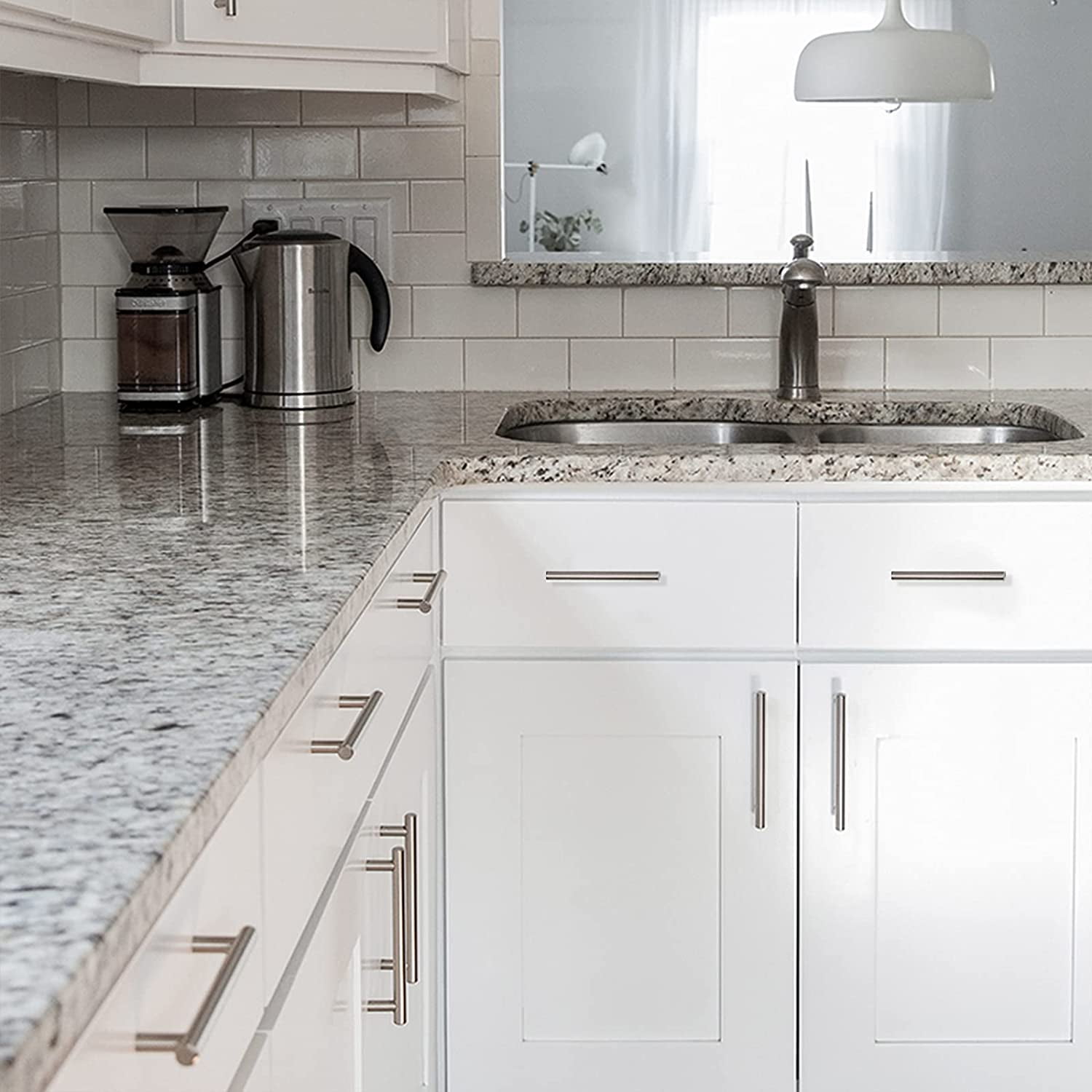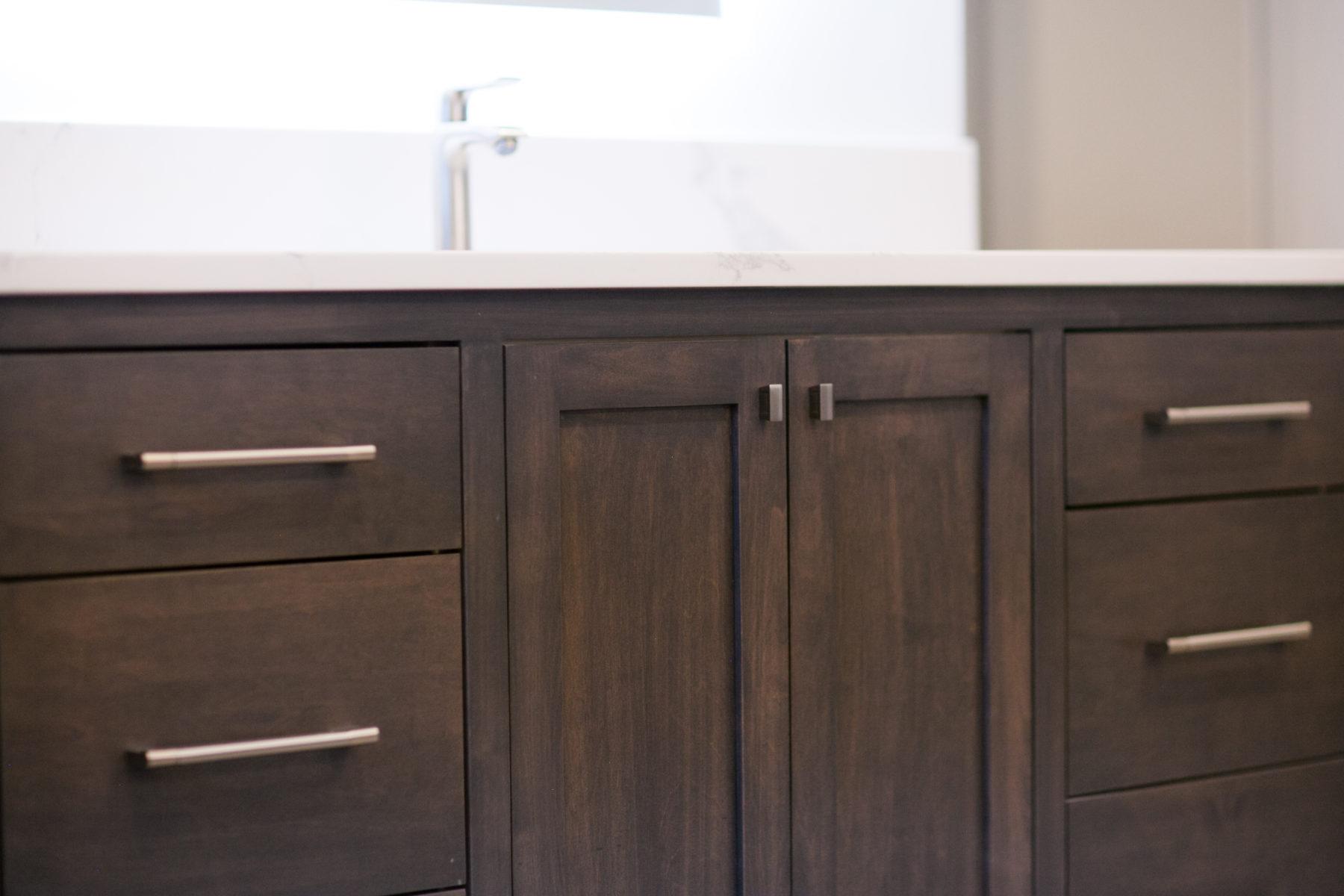Lowe’s Brushed Nickel Cabinet Hardware
Lowe’s offers a wide selection of brushed nickel cabinet hardware, providing homeowners with diverse options to enhance their kitchen aesthetics. This range caters to various design preferences and budgets, encompassing different styles, materials, and functionalities. The consistent brushed nickel finish offers a modern, sophisticated look that complements a variety of cabinet styles and overall kitchen designs.
Brushed Nickel Cabinet Hardware Range at Lowe’s, Lowes kitchen cabinet hardware brushed nickel
Lowe’s stock includes a broad spectrum of brushed nickel cabinet hardware, encompassing knobs, pulls, and handles in various shapes, sizes, and designs. The available styles range from minimalist and contemporary to more ornate and traditional. Finishes may vary slightly between manufacturers, but generally maintain a consistent brushed nickel appearance, characterized by a slightly textured surface that minimizes fingerprints and scratches. This consistent finish is a key selling point for many homeowners seeking a durable and aesthetically pleasing option. The selection also includes different materials, impacting durability and cost. Some hardware is made from zinc alloy, others from stainless steel, offering a range of options for homeowners with varying needs and budgets.
Comparison of Brushed Nickel Hardware Types
Brushed nickel knobs offer a compact and simple solution, ideal for smaller cabinets or drawers. They are generally less expensive than pulls or handles, and their small size makes them easy to install. Pulls, on the other hand, provide a more substantial grip and are suitable for larger cabinets or drawers where a stronger pull is needed. Handles offer a similar function to pulls, but often feature a more elongated design, providing a comfortable grip for opening larger doors and drawers. In terms of material, zinc alloy is a common and cost-effective choice, while stainless steel offers superior durability and resistance to corrosion. Aesthetically, the choice depends on personal preference and the overall kitchen design. Simple, round knobs lend themselves to minimalist styles, while more elaborate pulls and handles can complement traditional or transitional designs.
Brushed Nickel Hardware and Kitchen Cabinet Styles
The versatility of brushed nickel hardware allows it to seamlessly integrate with a variety of kitchen cabinet designs. The subtle texture of the brushed nickel finish complements both modern and traditional styles without overpowering the overall aesthetic.
| Style | Hardware Type | Cabinet Design | Description |
|---|---|---|---|
| Contemporary | Bar Pull | Slab | Sleek bar pulls in brushed nickel complement the clean lines of slab-door cabinets, creating a modern and minimalist look. The understated elegance of the hardware enhances the simplicity of the cabinet design. |
| Transitional | Cup Pull | Shaker | The slightly more ornate cup pulls in brushed nickel offer a subtle contrast to the classic Shaker style, creating a balanced and sophisticated appearance. The subtle detailing on the pulls adds visual interest without being overpowering. |
| Traditional | Knobs | Raised Panel | Small, detailed knobs in brushed nickel provide a classic touch to raised-panel cabinets. The subtle sheen of the brushed nickel finish complements the intricate detailing of the cabinet doors, maintaining a cohesive and elegant design. |
| Farmhouse | Long Pulls | Shaker | Longer, more substantial pulls in brushed nickel add a touch of rustic charm to Shaker cabinets, creating a warm and inviting farmhouse aesthetic. The brushed nickel finish maintains a sense of modernity, preventing the overall design from feeling overly dated. |
Installing Lowe’s Brushed Nickel Cabinet Hardware

Installing brushed nickel cabinet hardware from Lowe’s can significantly enhance the aesthetic appeal of your kitchen. This process, while seemingly straightforward, requires careful attention to detail to ensure a professional and long-lasting result. Proper measurement, drilling technique, and secure fastening are crucial for achieving a polished finish.
Tools and Materials Required for Installation
The success of your installation hinges on having the correct tools and materials readily available. Improper tools can lead to damage and frustration. A well-prepared workspace will significantly expedite the process.
- Measuring tape
- Pencil
- Drill with appropriate drill bits (pilot hole bit and a bit slightly smaller than the screw diameter)
- Screwdriver (Phillips head is most common)
- Level
- Cabinet hardware (knobs, pulls, handles from Lowe’s)
- Screws (ensure they are the correct length and type for your cabinet material)
- Optional: Wood filler (for patching holes if necessary)
- Optional: Sandpaper
Step-by-Step Installation Guide
This guide Artikels the general steps for installing various types of cabinet hardware. Always refer to the manufacturer’s instructions included with your specific Lowe’s hardware for detailed guidance.
- Measure and Mark: Accurately measure the placement of each piece of hardware, ensuring consistent spacing between knobs and pulls. Mark the locations with a pencil. Use a level to ensure horizontal alignment.
- Drill Pilot Holes (if necessary): For most hardware, especially in solid wood cabinets, drilling a pilot hole prevents splitting the wood. Use a pilot hole bit slightly smaller than the screw diameter. For softer woods or particleboard, a pilot hole may not be necessary.
- Install Knobs: Align the knob with the marked location and gently tighten the screw using a screwdriver. Avoid over-tightening, which can damage the knob or cabinet.
- Install Pulls: For pulls, align the mounting plate with the marked location and secure it with screws. Then, attach the pull handle to the plate. Again, avoid over-tightening.
- Install Handles: Similar to pulls, align the handle base with the markings and secure it with screws. Ensure the handle is level and securely fastened.
Troubleshooting Common Installation Problems
Several common issues can arise during installation. Addressing these proactively can save time and prevent frustration.
- Stripped Screws: If a screw strips, try using a slightly larger screw or a screw with a different thread pattern. If the hole is damaged, wood filler can be used to repair the hole before installing a new screw.
- Uneven Placement: Always use a level to ensure proper alignment. If hardware is uneven, remove it and re-measure and mark the location before reinstalling.
- Incorrect Screw Length: Using screws that are too long can damage the cabinet, while screws that are too short will not provide adequate support. Always use the screws provided with the hardware or screws of the correct length for your cabinet material.
- Cabinet Material Issues: Some cabinet materials, such as particleboard, may be more prone to damage during drilling. Use a lower drill speed and a sharp drill bit to minimize the risk of splintering.
Visual Representation of Screw Placement and Depth
The illustration depicts three common hardware types: a knob, a pull, and a handle. Each shows the appropriate screw placement and depth.
Lowes kitchen cabinet hardware brushed nickel – The illustration is a simple line drawing. The knob shows a single screw positioned centrally at the base, penetrating the cabinet door to a depth approximately halfway through the door’s thickness. The pull shows two screws, one at each end of the mounting plate, penetrating to a similar depth. The handle depicts two screws, positioned equidistantly from the center of the handle base, penetrating to the same depth as the knob and pull screws. Each screw’s depth is visually represented by a short line extending from the screw head into the cabinet door. Clear labels indicate each hardware type and the screw locations.
Brushed Nickel Hardware in Kitchen Design: Lowes Kitchen Cabinet Hardware Brushed Nickel

Brushed nickel kitchen cabinet hardware has become a popular choice among homeowners and designers, offering a versatile and sophisticated aesthetic that complements a wide range of kitchen styles. Its enduring appeal stems from its ability to blend seamlessly with both traditional and contemporary design elements, providing a timeless touch to the heart of the home. This section will explore current trends, integration strategies, and potential considerations when incorporating brushed nickel hardware into a kitchen design.
Current Trends in Brushed Nickel Kitchen Hardware
The popularity of brushed nickel hardware reflects a broader trend toward understated elegance and durable, low-maintenance finishes in kitchen design. Current trends show a preference for hardware with clean lines and simple silhouettes, often featuring minimalist designs that avoid excessive ornamentation. Larger pulls and knobs are also gaining traction, adding a touch of modern sophistication. The subtle reflectivity of brushed nickel complements the increasing use of matte finishes on cabinetry and countertops, creating a balanced and harmonious visual appeal.
Brushed Nickel Hardware Integration in Different Kitchen Styles
The versatility of brushed nickel allows for its seamless integration into various kitchen design aesthetics.
- Modern Kitchens: In modern kitchens characterized by sleek lines and minimalist designs, brushed nickel hardware complements the overall aesthetic. Imagine sleek, bar-shaped pulls on flat-panel cabinets, creating a clean and sophisticated look. The subtle sheen of the nickel adds a touch of visual interest without overwhelming the minimalist design.
- Traditional Kitchens: In more traditional kitchens, brushed nickel hardware can add a touch of contemporary refinement to classic details. Consider using ornate knobs or pulls with slightly more decorative elements, but still maintaining the brushed nickel’s understated elegance. The metal’s subtle texture complements the richness of traditional wood cabinetry.
- Farmhouse Kitchens: The warmth and rustic charm of a farmhouse kitchen can be enhanced by brushed nickel hardware. Larger, more substantial pulls, perhaps with a slightly more textured finish, can complement the natural materials and vintage-inspired elements common in this style. The brushed nickel’s durability also aligns well with the practical nature of a farmhouse kitchen.
Drawbacks and Limitations of Brushed Nickel Hardware
While brushed nickel offers many advantages, potential drawbacks should be considered.
- Maintenance: While relatively low-maintenance, brushed nickel hardware can show fingerprints and smudges more readily than some other finishes. Regular cleaning is necessary to maintain its appearance.
- Color Matching: Achieving perfect color matching across all brushed nickel hardware pieces can be challenging, particularly when sourcing from different manufacturers. Slight variations in tone can be noticeable, especially in well-lit kitchens.
- Style Limitations: While versatile, brushed nickel might not be the ideal choice for every kitchen style. Highly ornate or intensely colorful kitchens might benefit from hardware with a more striking finish.
